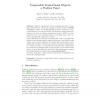Free Online Productivity Tools
i2Speak
i2Symbol
i2OCR
iTex2Img
iWeb2Print
iWeb2Shot
i2Type
iPdf2Split
iPdf2Merge
i2Bopomofo
i2Arabic
i2Style
i2Image
i2PDF
iLatex2Rtf
Sci2ools
ESOP
2014
Springer
2014
Springer
Composable Transactional Objects: A Position Paper
Abstract. Memory transactions provide programmers with a convestraction for concurrent programs: a keyword (such as atomic) designating a region of code that appears, from the perspective of concurrent threads, to execute atomically. Unfortunately, existing implementations in the form of software transactional memory (STM) are often ineffective due to their monolithic nature: every single read or write access is automatically tracked and recorded. In this statement, we advocate a transactional model of programming without a heavyweight software transactional memory, and describe some related, open research challenges. We suggest that a model based on persistent data structures could permit a variety of transactional algorithms to coexist in a library of composable transactional objects. Applications are constructed by snapping these objects together to form atomic transactions, in much the same way that today’s Java programmers compose their applications from libraries such as java....
| Added | 27 Apr 2014 |
| Updated | 27 Apr 2014 |
| Type | Journal |
| Year | 2014 |
| Where | ESOP |
| Authors | Maurice Herlihy, Eric Koskinen |
Comments (0)

